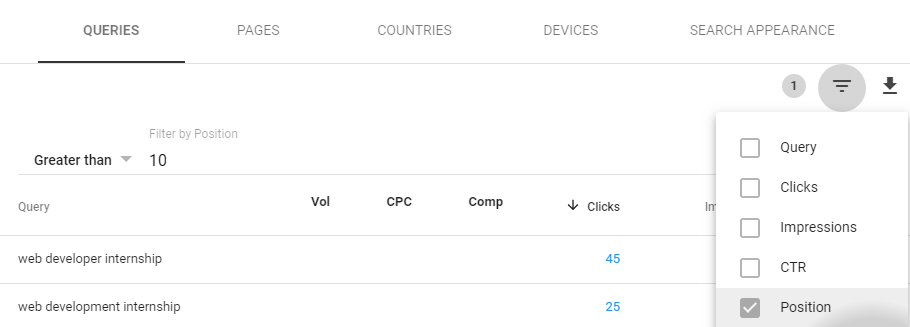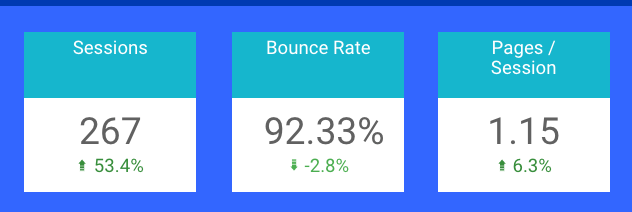
One SEO low-hanging fruit opportunity that doesn’t require creating new blog posts
So, you’re looking to get more free, organic traffic from Google with search engine optimization. But you’re limited on time and resources, so you can’t create new content as frequently as you’d like. What do you do?
Fortunately, there’s an SEO low-hanging fruit opportunity that will allow you to get more traffic with modest effort and a low time investment without having to create new content. A few years ago, we created an easy SEO technique called the Tipping-Point Keyword strategy, and we’re finally releasing it to the public. We’ve used this strategy to this day with great success—and so can you.
What is a tipping-point keyword?
A tipping-point keyword is a search term that your website is ranking for but not in the most favorable position, like on the second or third search engine result page (SERP). We call this a tipping-point keyword because it’s on the verge of getting a lot of traffic if we just move up its ranking position a few spots.
In the rest of this post, I’ll walk you through how to improve SERP rankings for pages that have a tipping-point keyword. But first, you must identify these keywords.
How to identify tipping-point keywords
- Go to Google Search Console.
- Verify your ownership of the site if you haven’t already.
- Click Performance on the left sidebar.
- Click the Date filter at the top. Change the date range to the last 28 days—depending on the amount of traffic obtained, you can choose a longer range than 28 days if you need more data.
- Click the Average position widget on the top, so it lights up in purple, because you’ll be shown the “Average position” column in the table on the webpage.

- Click the Queries tab in the table.
- Click the triangular menu button on the top right of the table, and select Position from the drop-down that appears. Doing this will open a Position filter at the top of the table called “Greater than.” Enter 10 in the value field as shown below.

- Look for relevant keywords in the table within the 11 to 49 Position range. It’s hard to raise the rank for keywords that are ranking at least 50, so avoid those.
- Narrow down your options by checking each keyword for high volume and low competition. Most SEO tools will tell you these numbers. If you can’t find any, choose keywords that are most relevant to your offer or audience.
- Spot-check the interesting keywords in incognito mode to make sure they still rank well. (Incognito is a browser mode that doesn’t track your cookies or search history beyond that session, so it won’t affect your current or future search history. We use it a lot to check rankings—because if you visit a page frequently, Google can use that data to serve that page higher in the rankings than they would have otherwise.)
- Most importantly, check the number of organic sessions on that page with Google Analytics. If there are already lots of sessions, that page is probably ranking for important keyword(s), so you don’t want to mess that up.
How to get your keyword ranking up in Google by tweaking your tipping-point page
Here are the tweaks you should make to a page once you’ve identified that it has a tipping-point keyword:
- Add the keyword to the body text at least once if it isn’t there already.
- Update the page title to include the keyword, preferably towards the front.
- Update the meta description so that it’s more compelling and benefits-driven to increase your click-through rate. Be sure also to include the keyword here.
- Add some related keywords with search volume to the content for contextual relevance.
- Build at least five internal links to this page. The more, the better. Building internal links means finding related pages on your site and having them link to the page in question.
For internal link building, I do a site search with the primary keyword to find relevant articles we’ve published. If that doesn’t turn up anything, I site-search related keywords. For example, if I’m optimizing a page for “corgi photos” and do a site search with no or few results, I would also do a site search for “dog photos” or “corgi pictures.” When you link, make sure the anchor text also matches a primary or related keyword.
Why tipping-point keywords help you get more traffic with less effort
Tipping-point keywords are some of the most impactful, time-efficient keywords to target because:
- You only have to update the content.
- You don’t have to create new content or dramatically rewrite existing content. You make tweaks to the page and site, which doesn’t take long.
- Google already acknowledges you as an authority because your content is already ranking decently.
This entire tipping-point keyword process takes around 30 minutes to an hour per page. Building relevant internal links to the page takes the longest, but that effort certainly pays off.
My experience using tipping-points keywords for real clients
I’ve seen landing page sessions increase for many pages on which we’ve used this tactic. For one client, we had an overall increase of 53.4% for organic sessions from month to month for the pages we worked on.

Some pages that didn’t move up in ranks as well as others—probably because the competition was too high, and further optimizations were needed to compete.

Parting thoughts
This SEO low-hanging fruit technique isn’t a one-and-done thing. When you’re posting new content, link back to old content to help it rank and start building a content pyramid. Don’t just wrap up a blog post and move on—revisit articles and check for rankings to identify which pages could use additional tweaks.
A good rule of thumb? Don’t do more harm than good. If a page is already obtaining lots of sessions, it ranks for something—skip the page if that ranking keyword is relevant. You can build internal links to a page without affecting existing rankings, so start there.
If you’re looking for how to improve traffic to your website, you can’t underestimate this tactic. Let me know how this strategy works out for you in the comments below.
Most newsletters suck...
So while we technically have to call this a daily newsletter so people know what it is, it's anything but.
You won't find any 'industry standards' or 'guru best practices' here - only the real stuff that actually moves the needle.






